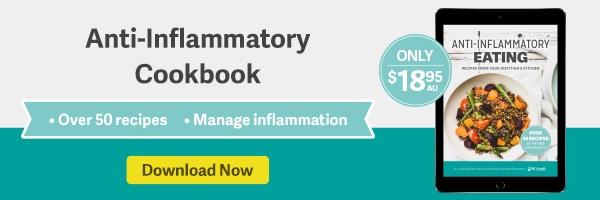Evidence for Anti-Inflammatory Eating
Since the release of our book ‘Anti-Inflammatory Eating’, we have been absolutely overwhelmed by the lovely feedback we have received. It is just so wonderful to know that so many people are enjoying something which has had so many hours of recipe experimenting, researching and all the other things that come with creating a book.
One part of the Anti-Inflammatory Eating Cookbook which we feel is particularly important is the research base behind it, so I wanted to share a little bit about how this was implemented, and why it was done.
As mentioned, one of the reasons the book came about in the first place is the client base that we work with at BJC. Many of our clients have health conditions, and wish to help manage these conditions with food. Just do a simple google search, there is A LOT of confusion about diet for management of all of these conditions. There is also a lot of confusion in the wider population about healthy eating in general, and what this looks like.
The recommendations in our cookbook have come about through two arms; first and foremost through research into the nutritional management of health conditions, such as rheumatoid arthritis, fibromyalgia, obesity and heart disease (among others, as you will see in the book), along with best ways of avoiding lifestyle related health conditions. Research terms included ‘nutrition rheumatoid arthritis’, ‘food reduce inflammation’, ‘nutrition gut health’, ‘food arthritis’, among others, as can be gleaned from checking out our reference list (page 132 of the book). Other papers were included that were already in our library of resources and journal articles, collected over years of working as dietitians. Particularly in relation to inflammatory joint conditions, there is still significant need for more research, and better quality research. We of course understand the evidence presented is not all from level A studies (yet wish it was), however the recommendations provide a means of people feeling more in control of their choices around their health, and health conditions.
Secondly, part of the recommendations arrive through professional experience. A clear example of this is people with gout, and inclusion, or exclusion of legumes. We always recommend that these are included, as this is now what the research is saying, however professional experience indicates that for many people with gout, they do report their symptoms are worse if they eat legumes too often. It would be remiss of us to tell someone to continue to regularly eat something which, when consumption is reduced, symptoms improve, and remiss to not mention in this book, as we are hoping to help many more people manage their health than just our current client base.
Inclusion of further research ourselves into nutritional management of arthritis and inflammatory joint conditions by our team at BJC has been a suggestion from a number of sources, and is certainly something which I am further exploring.
Again, we truly hope you enjoy the book, and the time that has been spent to get it to where it currently is. Please, do not hesitate to ask us questions about the book, or the research – as always, we are here to help.


